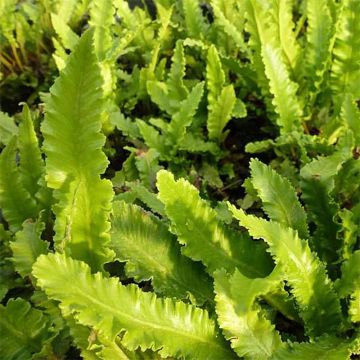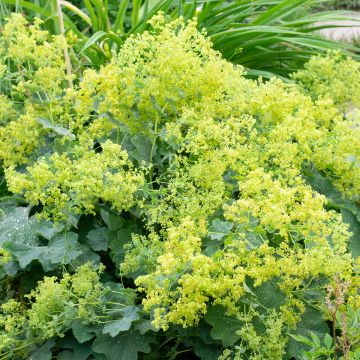

Asplenium trichomanes
Asplenium trichomanes
Asplenium trichomanes
Maidenhair Spleenwort
Already purchased a few years ago, it has developed well, which encouraged me to order again for another spot in the garden; arrived quickly, in good condition, planted immediately; awaiting its next expansion.
Martine, 02/11/2025
Special offer!
Receive a €20 voucher for any order over €90 (excluding delivery costs, credit notes, and plastic-free options)!
1- Add your favorite plants to your cart.
2- Once you have reached €90, confirm your order (you can even choose the delivery date!).
3- As soon as your order is shipped, you will receive an email containing your voucher code, valid for 3 months (90 days).
Your voucher is unique and can only be used once, for any order with a minimum value of €20, excluding delivery costs.
Can be combined with other current offers, non-divisible and non-refundable.
Home or relay delivery (depending on size and destination)
Schedule delivery date,
and select date in basket
This plant carries a 12 months recovery warranty
More information
We guarantee the quality of our plants for a full growing cycle, and will replace at our expense any plant that fails to recover under normal climatic and planting conditions.


Would this plant suit my garden?
Set up your Plantfit profile →
Description
Asplenium trichomanes, also known as Maidenhair Spleenwort, is a small evergreen fern that grows spontaneously in rocky and shaded areas. It is present in a wide area ranging from the mountain ranges of the Pyrenees and Alps to the Mediterranean coast. Hardy and adapted to Spartan conditions, this Maidenhair Spleenwort will thrive in gardens where the soil is scarce, such as in the crevices of walls, in rockeries, always far from the scorching sun.
Asplenium trichomanes belongs to the Aspleniaceae family, which includes about 700 species of terrestrial ferns, as well as those growing on tree branches (epiphytes) or on rocks (lithophytes). This Maidenhair Spleenwort, perennial with its erect rhizome, forms small, low and spreading but very dense tufts, 15 cm (6 in) tall and 20 cm (8i n) wide. Each tuft is composed of a multitude of leaves (called fronds) with almost black petioles and rachises. These slender fronds persist in winter, but can dry up in summer in case of drought, without harming the survival of the plant. Each frond, about 15 cm (6 in) long, is divided into 20 to 40 small rounded pinnules or divisions, of a lovely dark green colour with bronze reflections. The reproduction of this fern is ensured by the production of sori, which are small circular clusters of sporangia containing tiny spores. These sori, ranging from dark yellow to brown, form in the middle of spring on the undersides of the fronds. Note that this Asplenium thrives well in limestone soils.
This small fern, which thrives in shade or partial shade, finds its place in rockeries, on top of walls, or in the crevices of dry stone walls, which rarely receive direct sunlight. It can also be grown in pots, in a very well-draining mix. Under favourable conditions, it self-seeds in various places, always in rocky crevices, sometimes in the sun, sometimes in the shade depending on the region, but never in arid areas. Plant it also at the base of deciduous shrubs or along pathways. You can associate this Asplenium trichomanes with epimediums, hellebores, cyclamen hederifolium, and primroses, etc.
Report an error about the product description
Asplenium trichomanes in pictures


Foliage
Plant habit
Botanical data
Asplenium
trichomanes
Adianthaceae
Maidenhair Spleenwort
Western Europe
Other Asplenium
View all →Planting and care
Asplenium trichomanes appreciates well-drained soils, rich in stones, that do not retain water. This fern grows spontaneously in very little soil, for example in a pocket of compost between the stones of a wall, in a rock garden, above a low wall. It tolerates the sun in cool regions; elsewhere, shade or partial shade are absolutely necessary. The further south you go, the more it seeks north-facing exposures. Note that it tolerates limestone and dry soils in summer.
Planting period
Intended location
Care
-
, onOrder confirmed
Reply from on Promesse de fleurs
Similar products
Haven't found what you were looking for?
Hardiness is the lowest winter temperature a plant can endure without suffering serious damage or even dying. However, hardiness is affected by location (a sheltered area, such as a patio), protection (winter cover) and soil type (hardiness is improved by well-drained soil).

Photo Sharing Terms & Conditions
In order to encourage gardeners to interact and share their experiences, Promesse de fleurs offers various media enabling content to be uploaded onto its Site - in particular via the ‘Photo sharing’ module.
The User agrees to refrain from:
- Posting any content that is illegal, prejudicial, insulting, racist, inciteful to hatred, revisionist, contrary to public decency, that infringes on privacy or on the privacy rights of third parties, in particular the publicity rights of persons and goods, intellectual property rights, or the right to privacy.
- Submitting content on behalf of a third party;
- Impersonate the identity of a third party and/or publish any personal information about a third party;
In general, the User undertakes to refrain from any unethical behaviour.
All Content (in particular text, comments, files, images, photos, videos, creative works, etc.), which may be subject to property or intellectual property rights, image or other private rights, shall remain the property of the User, subject to the limited rights granted by the terms of the licence granted by Promesse de fleurs as stated below. Users are at liberty to publish or not to publish such Content on the Site, notably via the ‘Photo Sharing’ facility, and accept that this Content shall be made public and freely accessible, notably on the Internet.
Users further acknowledge, undertake to have ,and guarantee that they hold all necessary rights and permissions to publish such material on the Site, in particular with regard to the legislation in force pertaining to any privacy, property, intellectual property, image, or contractual rights, or rights of any other nature. By publishing such Content on the Site, Users acknowledge accepting full liability as publishers of the Content within the meaning of the law, and grant Promesse de fleurs, free of charge, an inclusive, worldwide licence for the said Content for the entire duration of its publication, including all reproduction, representation, up/downloading, displaying, performing, transmission, and storage rights.
Users also grant permission for their name to be linked to the Content and accept that this link may not always be made available.
By engaging in posting material, Users consent to their Content becoming automatically accessible on the Internet, in particular on other sites and/or blogs and/or web pages of the Promesse de fleurs site, including in particular social pages and the Promesse de fleurs catalogue.
Users may secure the removal of entrusted content free of charge by issuing a simple request via our contact form.
The flowering period indicated on our website applies to countries and regions located in USDA zone 8 (France, the United Kingdom, Ireland, the Netherlands, etc.)
It will vary according to where you live:
- In zones 9 to 10 (Italy, Spain, Greece, etc.), flowering will occur about 2 to 4 weeks earlier.
- In zones 6 to 7 (Germany, Poland, Slovenia, and lower mountainous regions), flowering will be delayed by 2 to 3 weeks.
- In zone 5 (Central Europe, Scandinavia), blooming will be delayed by 3 to 5 weeks.
In temperate climates, pruning of spring-flowering shrubs (forsythia, spireas, etc.) should be done just after flowering.
Pruning of summer-flowering shrubs (Indian Lilac, Perovskia, etc.) can be done in winter or spring.
In cold regions as well as with frost-sensitive plants, avoid pruning too early when severe frosts may still occur.
The planting period indicated on our website applies to countries and regions located in USDA zone 8 (France, United Kingdom, Ireland, Netherlands).
It will vary according to where you live:
- In Mediterranean zones (Marseille, Madrid, Milan, etc.), autumn and winter are the best planting periods.
- In continental zones (Strasbourg, Munich, Vienna, etc.), delay planting by 2 to 3 weeks in spring and bring it forward by 2 to 4 weeks in autumn.
- In mountainous regions (the Alps, Pyrenees, Carpathians, etc.), it is best to plant in late spring (May-June) or late summer (August-September).
The harvesting period indicated on our website applies to countries and regions in USDA zone 8 (France, England, Ireland, the Netherlands).
In colder areas (Scandinavia, Poland, Austria...) fruit and vegetable harvests are likely to be delayed by 3-4 weeks.
In warmer areas (Italy, Spain, Greece, etc.), harvesting will probably take place earlier, depending on weather conditions.
The sowing periods indicated on our website apply to countries and regions within USDA Zone 8 (France, UK, Ireland, Netherlands).
In colder areas (Scandinavia, Poland, Austria...), delay any outdoor sowing by 3-4 weeks, or sow under glass.
In warmer climes (Italy, Spain, Greece, etc.), bring outdoor sowing forward by a few weeks.















































